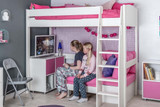Trains vs. Buses: Children on Public Transport
Your tween reaches a point when their social life requires transportation and you may not always be available to provide it. Public transportation, such as buses and trains, can provide the solution. However, along with their convenience come some challenges. This article will answer some common questions and concerns you may have about sending your children on public transport.
There are many benefits to using trains and buses:
- It connects teens with the community through public transportation and can have many positive benefits.
- Environmental benefits stem from use of public transportation.
- Using public transportation can also help teens build social and life skills.
- Use of trains and buses teach a teen independence and gives them freedom and responsibility.
It is important to help your teen become wise about the use of public trains and buses before they use them. Take the time to teach your teen how to decipher bus and/or train schedules and maps. If you live in a town with a local bus route or train, review the schedule together, pointing out the departure and arrival columns, the weekday versus weekend schedules, and any other pertinent information. You can also use the Internet to check schedules. Consider some hypothetical trips. You can also ride with your tween a few times to monitor their behaviour and make sure they are using good judgment and following rules for safety.
Before allowing your child to take a bus or train, make sure you are comfortable with their level of maturity and ability to follow some simple rules and guidelines. If your child is ready to use public transportation to go places with or meet friends, start with short distances during daylight hours.
The goal is to keep your child safe while giving them independence. To do so, follow a few simple guidelines:
- If possible, buy reduced-price bus or train passes that offer multiple rides for a set price.
- Remind them to be aware of surroundings and any people or situations that make them uncomfortable.
- If there are feelings of being unsafe, advise them to call home or tell the closest responsible adult.
- Talk about the potential of harassment and abuse.
- Talk about bus and train etiquette.
Once you are comfortable with their ability to make good decisions while riding buses and trains, share the following tips with them.
General Bus and Train Transportation Tips
- Know where you are going.
- Call home when you arrive as planned.
- Pay with exact fare, tokens, or passes to avoid displaying extra cash.
- Look for the busiest or best-lit stops.
- Grab an aisle seat and sit close to the driver or operator when possible.
- Stay aware of what is happening around you.
- Keep your backpack on your lap and do not display expensive-looking items.
- Move away from noisy or disruptive passengers.
Tips for Riding Buses
- Wait back from the curb at the bus stop.
- Once on the bus, do not block doors or lean on them.
- Hold on if you are standing while the bus is moving.
- Remember that city buses are not school buses. When passengers exit, city buses move away and other traffic does not stop.
- Avoid standing or walking in zones where drivers cannot see you.
Tips for Riding Trains
- Keep a safe distance from the platform edge.
- Do not sit on the platform edge.
- Do not play on the platform.
- Let others get off before you get on.
- Watch your step entering and exiting.
- Move to the centre.
- Hold onto something if you are standing.
- Do not lean on doors.
Teenagers especially have places they want to go and things they want to do that require them to use public transportation. Once they know how to use public trains and buses, there is a wide, wonderful world open to them.
Recent Posts
-
Unlocking the Potential of High Sleeper Beds for Teenagers
As teenagers go through all the ups and downs of being a teen, their likes and dislikes change a lot
-
Choosing Between a High Sleeper Bed vs. Mid Sleeper Bed
As your little one grows, so do their needs, and finding the perfect kids’ bed for them becomes









